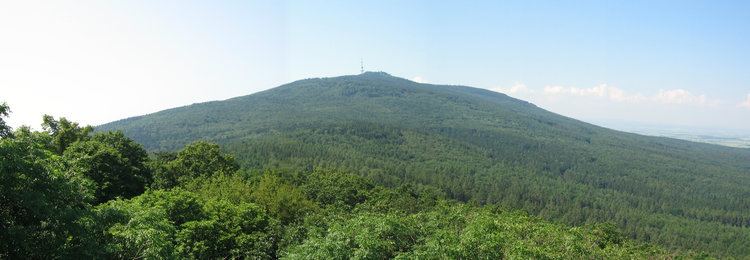Elevation 718 m Parent range Masyw Ślęży | Prominence 468 m | |
 | ||
Similar Radunia, Wielka Sowa, Králický Sněžník, Sněžka, Szczeliniec Wielki | ||
The Ślęża [ˈɕlɛ̃ʐa] (German: Zobten or Zobtenberg, later also Siling) is a mountain in the Sudeten Foreland (Polish: Przedgórze Sudeckie) in Lower Silesia, 30 km (19 mi) from Wrocław, southern Poland. This natural reserve built mostly of granite is 718 m high and covered with forests.
Contents
- Map of Mount C59AlC499C5BCa SobC3B3tka Poland
- Sacred mountain
- Etymology
- la in art and culture
- Transmitter
- References
Map of Mount %C5%9Al%C4%99%C5%BCa, Sob%C3%B3tka, Poland
The top of the mountain has a PTTK tourist Mountain hut, a TV and radio mast, church Mary, poorly visible ruins of the castle and observation tower. The mountain and its surrounding region form the protected area called Ślęża Landscape Park.
Sacred mountain
During the Neolithic Period and at least as far back as the 7th century BC Mount Ślęża (Zobten) was a holy place of the heathen tribes of the Lusatian culture. It was then settled by Celts and later by Germanic Lugians. Scientists believe that the sacred wood of the Alcis from Germanic mythology mentioned by Tacitus in his Germania was located on Mount Slęża. The Silingi, a subpopulation of the East Germanic tribe known as the Vandals are the earliest inhabitants of Silesia known by their name, however the greater part of them moved westwards after the 5th century A.D. and the remainder were slowly replaced in the 6th century by Slavic tribes who assimilated the few remaining East Germanic inhabitants. The Silingi were part of the Przeworsk culture. The name of the territory Silesia either derives from the Ślęza River, or from Mount Ślęża, which themselves derive their name from either, according to Germanist authors the Silingi people. or, according to Slavisist authors, the Ślężanie people.
The Slavic Ślężanie tribe settled in the area around the 6th Century AD. In the 10th Century, Mieszko I of the Piast dynasty incorporated Silesia into the Polish state. The etymology of the mountain is highly disputed between a Slavic, Germanic, or other Indo-European origin. The name has been recorded in several forms. As monte Silencii, in 1108, or as monte Slez in 1245.
Christianity came first via the Byzantine Church Slavonic missionaries saints Cyril and Methodius and by the diocese of Regensburg, then in the 10th century Bohemia received a bishopric, Prague, which was itself subject to the archbishopric of Mainz.
Mount Sleza was an ancient holy place for local tribes dedicated to a sun deity, and remained a holy place during Christian times as well. In the first half of the 12th century, the owner of the place was the Polish dukes' governor, Piotr Włostowic, who founded there an Augustinian convent which was subsequently moved to Wrocław in 1153.
Etymology
The Silesians may have been named after the Silingi, as the Silingi were inhabiting this region; Another explanation says that the word is perhaps derived from a Silesian word meaning "wet swampy place", the corresponding verb is "Ślęgnąć" meaning "to become wet".
Ślęża in art and culture
Mount Ślęża has been portrayed in the famous but atypical manner of Polish independent film (in Poland called Polskie Kino Niezależne) Edi800 in the movie Ślęża Manekin Project III.
Transmitter
On Ślęża there is a facility for FM- and TV-transmission, which uses a 136 metre tall free-standing (with additional guying) lattice tower. The current tower which was built in 1972 replaced a 98 metre tall tower built in 1957, which was partially guyed.
